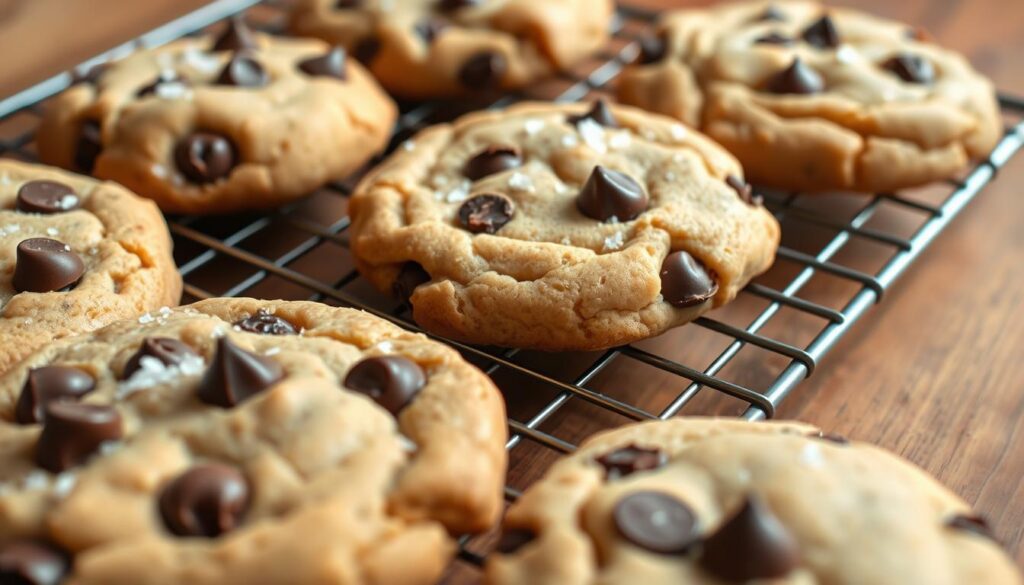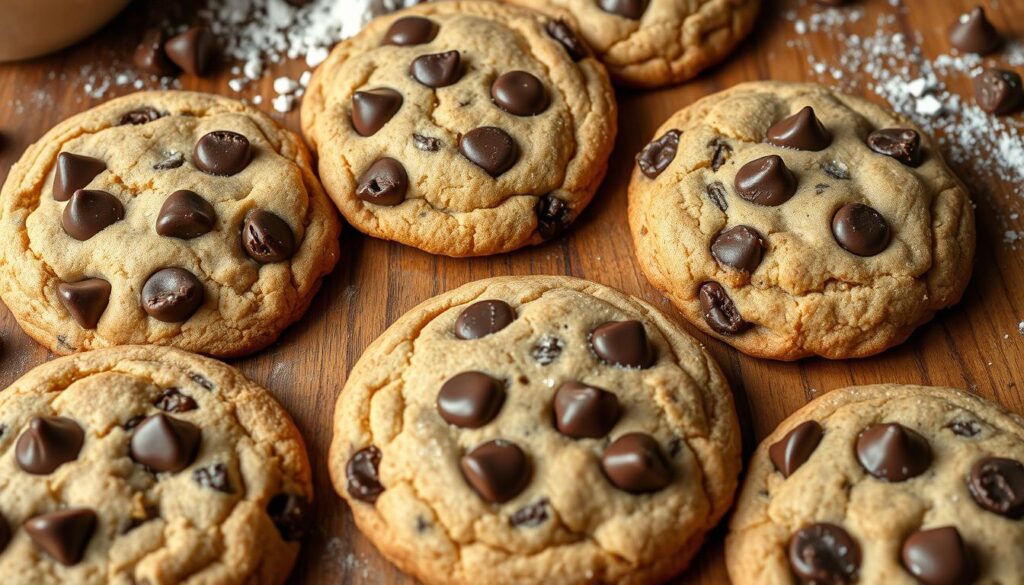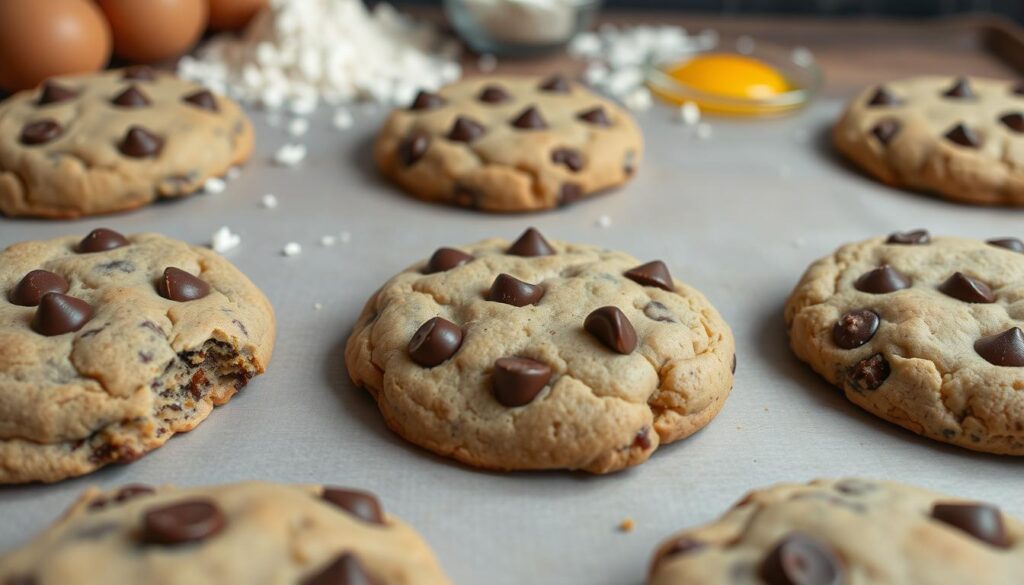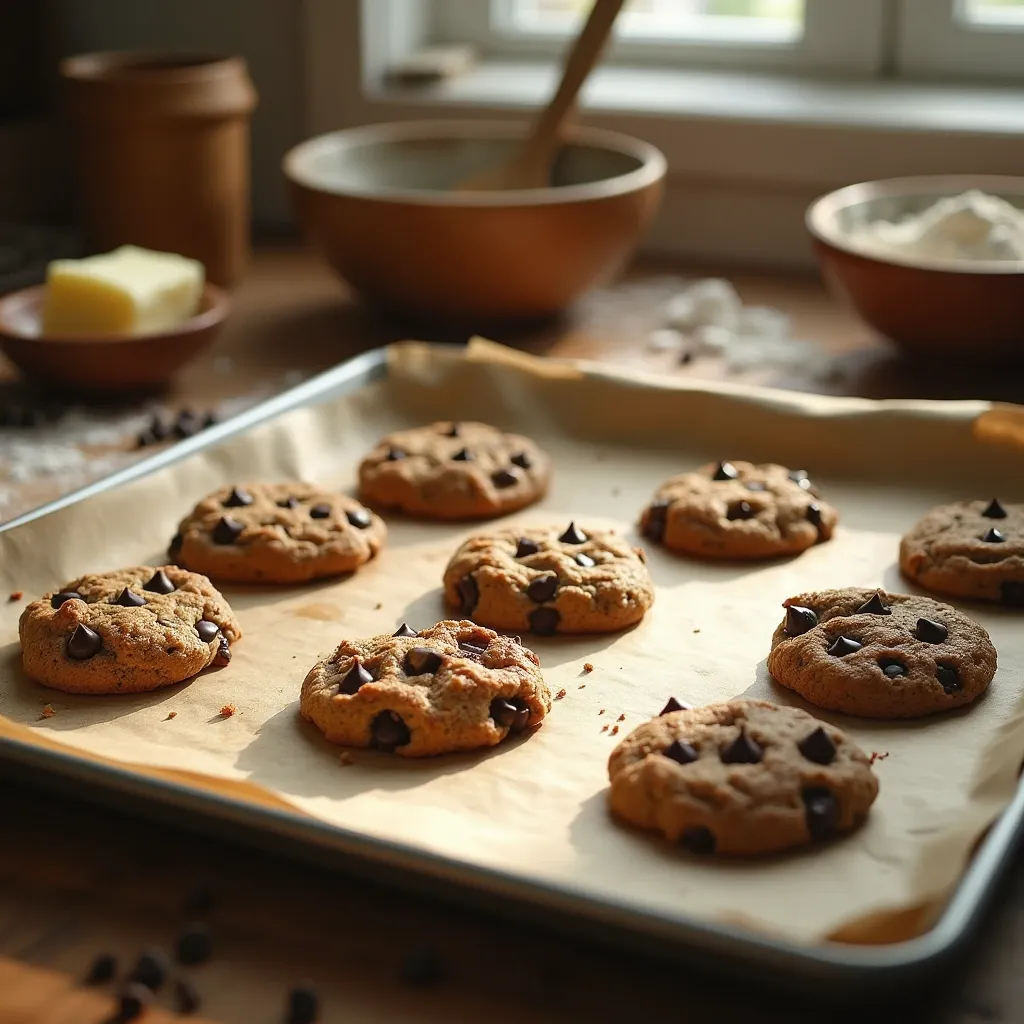If you’ve ever pulled a tray of chocolate chip cookies from the oven only to find them flat, you’re not alone. Many home bakers face the frustrating challenge of creating cookies that rise to the occasion. Understanding why your cookies might be turning into flat cookies instead of fluffy delights is essential for achieving that perfect texture. In this article, we will explore the *cookie baking tips* that help answer the pressing question: why aren’t my chocolate chip cookies puffy?
By examining common issues and providing practical solutions, you’ll be well on your way to mastering the art of cookie baking. From adjusting ingredients to specific techniques, our goal is to ensure your next batch of chocolate chip cookies is an impressive, puffy treat that everyone will enjoy.

Key Takeaways
- Proper cookies require the right ratio of flour to ensure that puffy texture.
- Overmixing the dough can lead to tough cookies, impacting their puffiness.
- Butter temperature plays a critical role; aim for room temperature around 65-70°F.
- Using parchment paper can help prevent cookies from spreading too much.
- Keep an eye on baking time; remove cookies when they’re soft for best results.
- Adjust ingredient ratios, like flour or eggs, to avoid overly flat or crispy outcomes.
Understanding Cookie Texture
Mastering cookie baking starts with knowing about cookie texture. You might like chewy cookies or prefer them crunchy. Knowing this lets you make cookies just the way you like them.
Different Types of Cookie Preferences
There are many types of cookies:
- Crispy Cookies: These are light and crunchy, thanks to less moisture and more sugar.
- Chewy Cookies: They have a soft center and a denser edge, thanks to brown sugar.
- Cake-Like Cookies: These are fluffy and airy, needing more eggs and baking powder.
Knowing these types helps you bake better, making cookies that fit your taste.
The Science Behind Cookie Texture
Baking science shows how ingredients affect cookie texture. Flour types, for example, have different protein levels:
| Flour Type | Protein Percentage |
|---|---|
| Cake Flour | 6-8% |
| Pastry Flour | 7-9.5% |
| All-Purpose Flour | 9.5-12% |
| Bread Flour | 11.5-14% |
| Whole-Wheat Flour | 13-14% |
Choosing the right ingredients changes cookie texture. Using cake flour makes cookies softer. Knowing how ingredients work together is key to perfect cookies.

Common Reasons for Flat Cookies
Want to make the perfect chocolate chip cookie? Knowing why cookies often turn out flat is key. Focus on the right ingredients and their amounts to bake better cookies.
Insufficient Flour in Your Recipe
Flour is essential for cookie structure. Too little flour makes dough unstable, causing it to spread instead of puff. Always measure flour correctly to avoid this problem.
Using Melted or Too Warm Butter
The butter’s state is critical for cookie texture. Melted butter makes dough too soft, leading to flat cookies. Butter should be soft but not melted. Use a thermometer for precise temperature.
Excessive Sugar Impacting Structure
Too much sugar harms cookie structure. Sugar melts in heat, causing dough to spread. Stick to the recipe’s sugar amounts to get the right texture.

| Issue | Impact on Cookies | Solution |
|---|---|---|
| Insufficient Flour | Causes spreading and lack of structure | Use the correct measuring technique for flour |
| Melted or Warm Butter | Leads to flat cookies due to excessive spreading | Ensure butter is at room temperature, not melted |
| Excessive Sugar | Prevents cookies from rising properly | Follow sugar measurements in the recipe |
Why Aren’t My Chocolate Chip Cookies Puffy?
Understanding why your chocolate chip cookies aren’t puffy involves looking at eggs and leavening agents. The egg quantity and the choice between baking soda and baking powder are key. These factors greatly affect your cookies’ texture.
Impact of Egg Quantity on Texture
The number of eggs in your recipe is very important for texture. Too many eggs can make cookies spongy and cakelike, losing their crust. Not using eggs can make them dry and crumbly. The right amount of eggs helps bind ingredients and makes the cookies moist and rich.
Effect of Baking Soda vs. Baking Powder
Choosing between baking soda and baking powder is critical for puffiness. Baking soda makes cookies spread out, giving them a chewy texture. Baking powder, on the other hand, makes them lift and can make them taste caky. Trying different leavening agents helps you find the perfect texture for your cookies.
| Ingredient Type | Effect on Cookies |
|---|---|
| Eggs (Too Many) | Spongy and cakelike texture with no crust |
| No Eggs | Dry, salty, and crumbly texture |
| Baking Soda | Leads to spread; chewy cookies |
| Baking Powder | Creates lift; caky and potentially artificial flavor |
| Optimal Egg Quantity | Produces a rich, moist cookie without excess fluff |
Adjusting Ingredients for Better Rise
To get your cookies to rise better, it’s key to adjust ingredients right. Choosing the right ingredients and measuring them correctly can make a big difference. Knowing how flour ratios and sugar mixes work together is important for making cookies that rise well.
Finding the Right Flour Ratio
The flour you pick affects your cookie’s rise. All-purpose flour, with 11.7% protein, is common in cookie recipes. Bread flour, with 12.7% protein, can add more structure. You can replace all-purpose flour with bread flour 1:1 by weight for better rise and texture.
Trying different flour mixes can lead to great results.
Correct Sugar Combinations for Puffiness
The sugars in your recipe affect moisture and structure. Using white and brown sugars together can help your cookies rise. For chewier cookies, use more brown sugar, aiming for a 1 ½:1 white sugar ratio.
Getting the right sugar combinations will improve your cookie’s rise, texture, and taste.
Importance of Mixing Techniques
Mixing techniques are key in making cookie dough. They help mix ingredients well, affecting the cookie’s texture. It’s important to mix just right, avoiding overmixing.
Overmixing can make cookies tough because it develops gluten. So, it’s vital to control how long and how you mix. This ensures your cookies are fluffy.
How Overmixing Affects Cookies
Good mixing adds just the right amount of air to the dough. This makes cookies light and airy, which is what we all want. But, overmixing adds too much air, making cookies dense and less tasty.
To get perfect cookies, mix for just the right amount of time. This way, you avoid making them tough. Follow these tips to make your cookies fluffy and delicious.
Environmental Factors That Influence Baking
The success of your chocolate chip cookies depends on several environmental factors. Knowing how room temperature ingredients and baking sheet choices impact your baking is key. Making sure your ingredients and equipment are in the best condition can greatly improve your baking skills.
Room Temperature of Ingredients
Using room temperature ingredients is essential for baking. Butter at room temperature is critical for the right texture and structure of chocolate chip cookies. Cold butter can make the cookies dense because it doesn’t cream properly with sugar.
Eggs should also be at room temperature. This ensures even mixing and proper chemical reactions during baking. Properly measuring sugar is also important. Incorrect measurements can change the sweetness and texture of your cookies.
Baking Sheet Considerations
Your choice of baking sheet can greatly affect your cookies. Thicker, heavier baking sheets spread heat evenly, preventing cookies from spreading too much. It’s wise to use an oven thermometer to ensure your oven is at the right temperature.
Preheating the oven correctly prepares it for baking. This helps avoid uneven baking. Rotating your baking sheet halfway through baking prevents uneven heat distribution. This affects the texture and appearance of your cookies.
Baking Techniques for Fluffy Cookies
Using the right baking techniques can make your chocolate chip cookies fluffier. Chilling the dough and adjusting baking time and temperature are key. These methods help you bake cookies that taste great and look good too.
Chilling Dough Before Baking
Chilling the dough is a step many bakers miss. It makes the fat in the dough solid. This stops the cookies from spreading too much while baking.
Chilling the dough for at least 30 minutes can really improve your cookies. They become thicker and puffier.
Timing and Temperature Adjustments
Getting the timing and temperature right is important for the best texture. Chocolate chip cookies usually bake for 10 to 12 minutes. Baking at the right temperature helps them rise just right.
Always check your cookies while they’re baking. Small changes in baking time can affect how puffy they get.
| Technique | Benefit |
|---|---|
| Chilling Dough | Prevents excessive spreading, resulting in thicker cookies. |
| Timing Adjustment | Delivers the ideal texture by avoiding under or overbaking. |
| Temperature Control | Ensures even baking, contributing to a perfect rise. |
By using these baking techniques, you can make amazing cookies. Remember, making perfect cookies is all about trying new things. So, don’t be afraid to experiment until you find your favorite way to bake.
Experimenting with Recipes
Trying out new recipes can be exciting in baking. A good cookie recipe, like the Nestle Toll House Chocolate Chip Cookie, is a great start. It’s loved for its taste and how you can change it to make it your own. This lets you play with flavors and textures, learning as you go.
Using a Reliable Recipe, Like Nestle Chocolate Chip Cookie Recipe
Choosing a reliable recipe is key to making great cookies. The Nestle Toll House recipe has the right mix of sugars, flour, and eggs. You can tweak it to make your cookies even better. For example, you might cut down on sugar or use bread flour for chewiness. Each change can make your cookies unique and fun to make.
Trying Different Types of Fats
Fats in cookies affect their taste and texture. Butter gives a rich flavor and a spready texture. Shortening makes cookies different. Mixing both fats gives you the best of both worlds.
When you try different fats, think about their temperature and how they mix with other ingredients. Chilling the dough before baking can also improve flavor and texture. This way, your cookies will turn out just right.
Conclusion
To make the perfect puffy chocolate chip cookie, you need to know your ingredients and techniques well. This guide has shown how important it is to measure ingredients accurately. Using high-quality butter, like European butter, improves taste and texture.
Also, make sure your ingredients are at room temperature. This helps them mix better, making your cookies turn out great.
The type of flour you use is also key. While all-purpose flour works well, trying bread flour or cake flour can make a difference. Using the right mixing techniques, like creaming butter and sugar, is vital for a light cookie.
Remember, small changes can make a big difference in baking. Paying attention to oven temperature, baking time, and chilling can help you find your perfect cookie recipe. So, keep trying and adjusting your methods. Your perfect chocolate chip cookies are just around the corner!
FAQ
Why do my chocolate chip cookies come out flat?
Flat cookies can happen if you use too little flour or if your butter is melted. Also, too much sugar can cause them to spread too much. Make sure to measure your ingredients right and check your butter’s temperature before mixing.
What kind of flour should I use for puffy cookies?
For puffy cookies, all-purpose flour is the best. It gives the right amount of structure without making the cookies hard.
How does the amount of eggs affect my cookie texture?
The number of eggs you use is key to your cookie’s texture. Too many eggs can make the cookies too soft or cake-like. But the right amount helps them puff up and stay moist.
Should I use baking soda or baking powder for chocolate chip cookies?
Baking powder is great for puffy cookies because it adds lift. Baking soda makes cookies spread out, so choose based on what you like.
How can I prevent overmixing the cookie dough?
Mix the dough just until it’s combined. This avoids adding too much air and keeps the cookies from getting tough or spreading too much.
Does chilling the dough really make a difference?
Yes, chilling the dough helps. It keeps the fat stable and reduces spreading, making your cookies rise better.
What environmental factors should I consider when baking cookies?
Use room temperature ingredients for better mixing and baking. Also, a thick, heavy baking sheet helps even out the heat and prevents spreading.
Can I experiment with different types of fats in my cookie recipe?
Absolutely! Trying different fats, like butter and shortening, can change your cookies’ taste and texture. It’s a great way to find your favorite.

